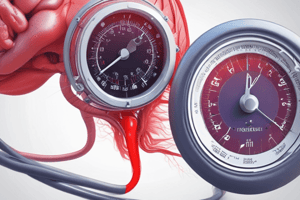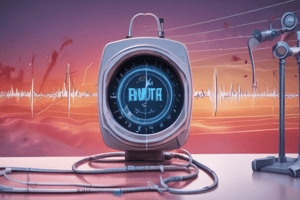Podcast
Questions and Answers
How would performing a blood pressure measurement immediately after a patient consumes a large cup of coffee likely affect the reading?
How would performing a blood pressure measurement immediately after a patient consumes a large cup of coffee likely affect the reading?
- It would not significantly affect the blood pressure reading if the patient is a regular coffee drinker.
- It would falsely lower the systolic pressure due to vasodilation.
- It would falsely lower the diastolic pressure while elevating the systolic pressure.
- It would falsely elevate both systolic and diastolic pressures due to caffeine's stimulant effect. (correct)
In a patient with significant anxiety about medical procedures, what is the most appropriate method to mitigate the 'white coat effect' during blood pressure measurement?
In a patient with significant anxiety about medical procedures, what is the most appropriate method to mitigate the 'white coat effect' during blood pressure measurement?
- Have the patient take the first measurement at home using an automated device. (correct)
- Administer a mild sedative 15 minutes before the measurement.
- Distract the patient by engaging in a complex conversation during the measurement.
- Take the blood pressure measurement immediately upon the patient entering the room to minimize anticipation.
How would using a blood pressure cuff that is too small for a patient's arm affect the blood pressure reading?
How would using a blood pressure cuff that is too small for a patient's arm affect the blood pressure reading?
- It would accurately reflect the patient's true blood pressure regardless of arm size.
- It would falsely elevate both systolic and diastolic blood pressure. (correct)
- It would falsely lower both systolic and diastolic blood pressure.
- It would only affect systolic pressure, causing it to read lower than actual.
What is the impact of positioning the patient's arm above heart level during blood pressure measurement?
What is the impact of positioning the patient's arm above heart level during blood pressure measurement?
How does recent physical activity, such as brisk walking, affect blood pressure measurements, and what is the recommended waiting period before taking a measurement?
How does recent physical activity, such as brisk walking, affect blood pressure measurements, and what is the recommended waiting period before taking a measurement?
In the context of blood pressure measurement, what is the significance of auscultatory gap, and how should it be addressed?
In the context of blood pressure measurement, what is the significance of auscultatory gap, and how should it be addressed?
How does bladder distention impact blood pressure readings and what is the physiological mechanism behind this effect?
How does bladder distention impact blood pressure readings and what is the physiological mechanism behind this effect?
For elderly patients with rigid arteries, what adjustment in the standard blood pressure measurement technique may be necessary to obtain more reliable results?
For elderly patients with rigid arteries, what adjustment in the standard blood pressure measurement technique may be necessary to obtain more reliable results?
How does the 'observer bias' impact blood pressure measurement, and what strategies can minimize this effect?
How does the 'observer bias' impact blood pressure measurement, and what strategies can minimize this effect?
In patients with lymphedema in one arm, how should blood pressure be accurately measured?
In patients with lymphedema in one arm, how should blood pressure be accurately measured?
Flashcards
Blood Pressure
Blood Pressure
The force exerted by circulating blood on the walls of blood vessels, typically measured in millimeters of mercury (mmHg).
Systolic vs. Diastolic Pressure
Systolic vs. Diastolic Pressure
Systolic pressure is the highest pressure when the heart contracts. Diastolic pressure is the lowest pressure when the heart relaxes.
Factors Affecting Blood Pressure
Factors Affecting Blood Pressure
Age, stress, diet, exercise, and medications can influence blood pressure readings.
Stimulants' Effect on BP
Stimulants' Effect on BP
Signup and view all the flashcards
White Coat Hypertension
White Coat Hypertension
Signup and view all the flashcards
Importance of Cuff Size
Importance of Cuff Size
Signup and view all the flashcards
Short-Term Influences on BP
Short-Term Influences on BP
Signup and view all the flashcards
Diurnal Variation in BP
Diurnal Variation in BP
Signup and view all the flashcards
Body Position Effects
Body Position Effects
Signup and view all the flashcards
Study Notes
- 血压测量值会受到多种因素的影响,了解这些因素对于获得准确的血压读数至关重要。这些因素可以分为生理性因素、环境因素、测量技术因素以及患者相关因素等。
生理性因素
- 年龄会影响血压,通常血压随年龄增长而升高。
- 性别也会影响血压,成年男性通常高于成年女性,但女性在更年期后血压可能会升高。
- 昼夜节律导致血压在一天中波动,通常夜间较低,清晨升高。
- 运动会使血压升高,剧烈运动后尤为明显。
- 精神压力、焦虑或激动会导致血压暂时升高。
- 姿势会影响血压,站立时血压通常高于坐位或卧位。
环境因素
- 温度会影响血压,寒冷环境可能导致血管收缩,血压升高。
- 海拔也会影响血压,高海拔地区由于氧气稀薄,可能导致血压升高。
- 测量环境嘈杂、拥挤或不舒适,会引起患者紧张,导致血压升高。
测量技术因素
- 使用不准确或未经校准的血压计,可能导致读数不准确。
- 袖带尺寸不合适会影响测量结果,袖带过小会导致血压读数偏高,袖带过大则可能偏低。
- 袖带绑得过松或过紧,均会导致测量误差。
- 听诊器放置位置不正确会影响柯氏音的听取,影响判断。
- 充气或放气速度过快或过慢,影响测量准确性。
- 重复测量间隔时间过短,可能导致血压读数降低。
- 测量者缺乏经验或操作不规范,会导致测量误差。
患者相关因素
- 吸烟会导致血压暂时升高。
- 饮酒,特别是大量饮酒,会使血压升高。
- 摄入过多的盐分(钠)会导致血压升高。
- 饮用咖啡或其他含咖啡因的饮料会暂时升高血压。
- 某些药物,如非甾体抗炎药(NSAIDs)、避孕药和感冒药等,可能升高血压。
- 膀胱充盈会影响血压,测量前应排空膀胱。
- 测量前未充分休息,例如剧烈运动或情绪激动后立即测量,会使血压升高。
- 白大衣效应,即患者在医疗环境中由于紧张而导致血压升高。
- 某些疾病,如糖尿病、肾脏疾病和甲状腺疾病等,会影响血压。
- 肥胖通常与高血压相关。
- 测量时说话或移动会影响血压读数。
- 测量时双腿交叉可能会导致血压升高。
- 遗传因素也会影响血压水平。
如何减少影响因素
- 选择合适的血压计并定期校准。
- 确保袖带尺寸合适。
- 在安静、舒适的环境中测量血压。
- 测量前休息至少5分钟。
- 避免在测量前吸烟、饮酒或饮用咖啡。
- 测量时保持正确的姿势,双脚平放在地面上,不要交叉双腿。
- 测量时保持安静,不要说话或移动。
- 多次测量取平均值,以减少误差。
- 排除疾病和药物的影响。
- 采用家庭血压监测,减少白大衣效应。
- 建议由经过培训的医护人员进行血压测量。
Studying That Suits You
Use AI to generate personalized quizzes and flashcards to suit your learning preferences.




